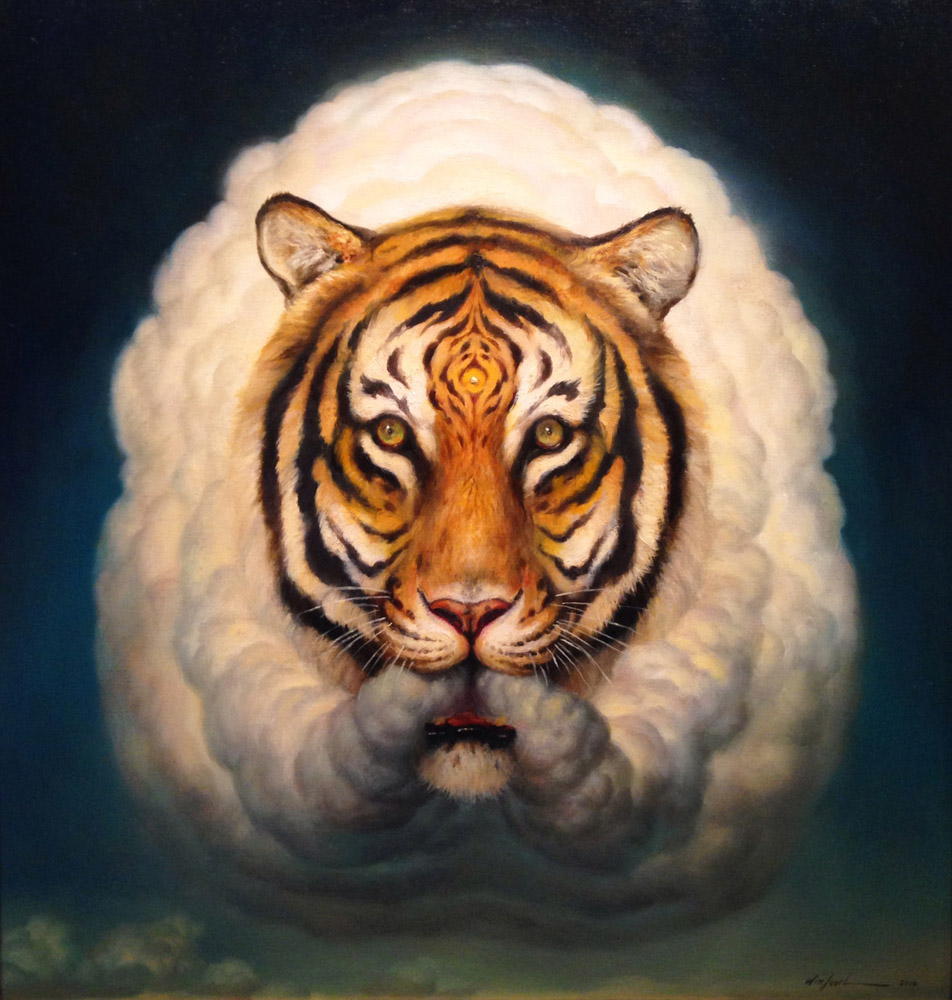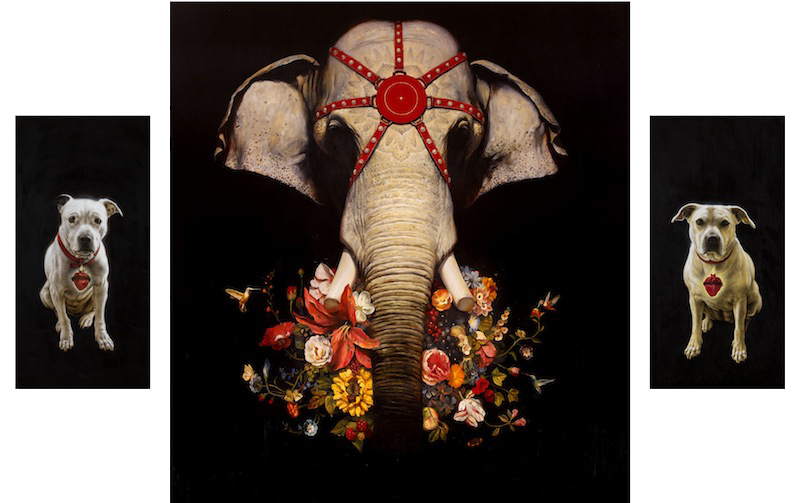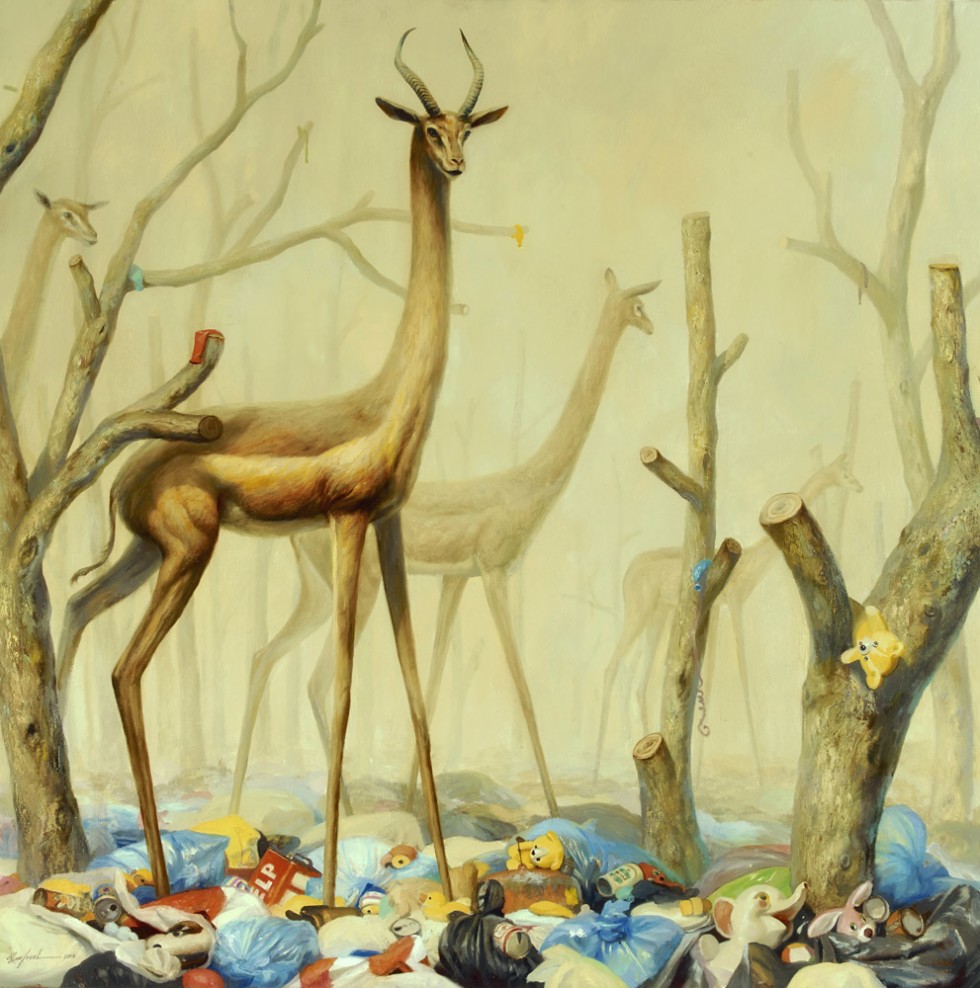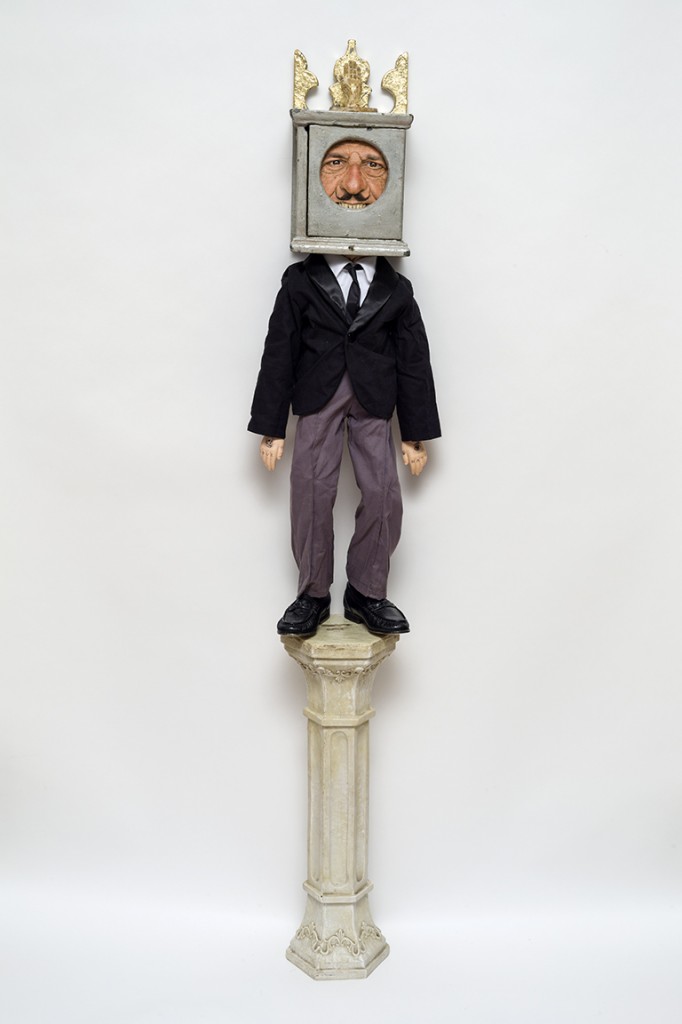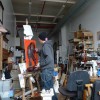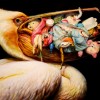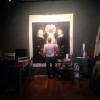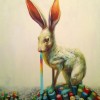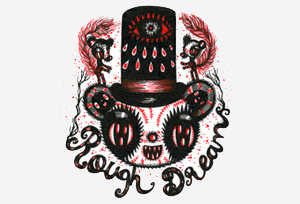Interview | Martin Wittfooth x Jean Labourdette
[Scroll down for English]
Fanny Giniès : Pourriez-vous résumer votre parcours en quelques mots ?
Martin Wittfooth : J’ai grandi en Finlande. Mon grand-père était illustrateur et ma tante, du côté de ma mère, est professeur de dessin. Mon intérêt pour l’art a été éveillé dès le plus jeune âge grâce à eux. Quand j’ai déménagé au Canada, j’ai commencé à étudier l’illustration. Je pensais devenir illustrateur commercial, pendant un temps j’ai gagné ma vie en concevant des dessins pour des planches de snowboard. Puis je me suis installé à New York pour passer un Master à la School of Visual Arts. J’ai eu mon diplôme d’arts plastiques, spécialité Illustration, en 2008. Pendant cette année d’études, je me suis éloigné des boulots commerciaux, où le seul objectif est la rentabilité, pour me concentrer sur des œuvres plus personnelles. J’ai commencé à exposer dès ma sortie de l’école et c’est tout ce à quoi je me consacre depuis.
Jean Labourdette : Pour ma part, Je suis autodidacte. Mon père était artiste et prof de dessin donc j’ai quand même grandi dans un univers artistique. Enfant, j’ai lu beaucoup de BD. Puis j’ai commencé à faire du graffiti à partir de l’âge de 12 ans et c’est vraiment ça qui m’a mis dans une approche de peinture. A partir de là j’ai fait mon chemin, de la BD, de l’illustration et de la peinture à partir des années 1990. Puis j’ai quitté la France pour Montréal en 2001 et j’ai fait une transition graduelle de l’illustration à la peinture. Depuis 2004-2005, je vis uniquement de la peinture, c’est mon activité à plein temps.
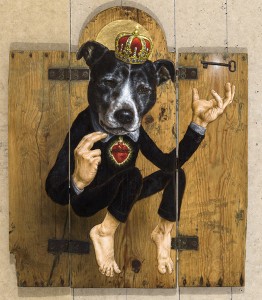 L’année dernière, dans le cadre de l’exposition « HEY ! Modern Art & Pop Culture, part II », vous exposiez un triptyque qui scellait votre 1ère collaboration artistique. Est-ce à ce moment là qu’est née l’envie de retravailler ensemble sur un projet plus important ?
L’année dernière, dans le cadre de l’exposition « HEY ! Modern Art & Pop Culture, part II », vous exposiez un triptyque qui scellait votre 1ère collaboration artistique. Est-ce à ce moment là qu’est née l’envie de retravailler ensemble sur un projet plus important ?
Jean Labourdette : Ca fait déjà quelques années que Martin et moi parlions de mettre en place des projets collaboratifs. Le triptyque que nous avons réalisé pour HEY! part II a été la première concrétisation de cette envie de bosser ensemble. C’était aussi une manière de tester notre capacité à travailler à deux sur une seule pièce cohérente, de voir si nos travaux respectifs pouvaient cohabiter et s’enrichir l’un l’autre au sein d’une même œuvre… Cette première expérience s’est très bien passée et donc, dans la même direction, nous avons poussé le dialogue artistique encore plus loin cette fois-ci avec une exposition collaborative entière.
Quel est le thème général de cette nouvelle exposition justement : “De Anima”. Et à quoi ce titre fait-il référence ?
Martin Wittfooth : Nous avons emprunté ce titre à un traité d’Aristote, « De l’Âme » (« On the Soul »), car notre exposition explore une question centrale de la culture mondiale actuelle : lorsque la nature cesse d’être notre temple, et se voit transformée en notre terrain de jeu, que perdons-nous ? Nous avons à cœur de souligner cette dualité qui existe chez l’homme moderne, qui objective et marchandise le vivant, tout en portant une attention grandissante aux expériences technologiques externalisées, supervisées (telles que la projection d’un soi idéalisé sur les réseaux sociaux).
Combien d’œuvres exposez-vous à la galerie Roq La Rue ? Y aura-t-il seulement des peintures, ou bien d’autres types de travaux également ?
Jean Labourdette : Je présente 8 œuvres en tout, 5 peintures et 3 sculptures.
Martin Wittfooth : Je présente 8 peintures individuelles aussi et un grand triptyque collaboratif réalisé avec Jean. J’ai commencé à introduire de la feuille d’or dans ce corpus d’œuvres, car j’ai l’impression que cela rentre dans le vocabulaire de l’imagerie sacrée.
Que représente ce triptyque et comment vous êtes-vous partagé le travail tous les deux ?
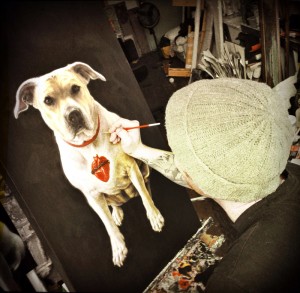 Jean Labourdette : Pour le triptyque, j’ai réalisé les deux panneaux latéraux et Martin le panneau central. Nous avons fait plusieurs sessions de travail ensemble dans un même lieu à différents stades du processus, soit dans mon atelier à Montréal ou dans celui de Martin à NY.
Jean Labourdette : Pour le triptyque, j’ai réalisé les deux panneaux latéraux et Martin le panneau central. Nous avons fait plusieurs sessions de travail ensemble dans un même lieu à différents stades du processus, soit dans mon atelier à Montréal ou dans celui de Martin à NY.
Martin Wittfooth : Le triptyque est intitulé “Incantation”, ce qui fait référence à une série de mots visant à produire un charme magique. Dans mon panneau, j’ai voulu évoquer les caractéristiques d’un mandala, symbole d’équilibre : l’éléphant est harnaché d’une tiare de cirque, ses défenses sont sciées – ce qui suggère l’influence du genre humain et la marchandisation de l’animal. Les formes naturelles autour jouent un rôle compensatoire, elles complètent la composition ronde sous-jacente. J’ai puisé cette imagerie en grande partie d’expériences avec des substances psychédéliques à base de plantes, que beaucoup d’observateurs – moi y compris, pensent être un bon moyen pour communiquer avec la nature.
En quoi ce nouvel ensemble d’œuvres diffère t-il de vos créations plus anciennes ? Pensez-vous avoir approfondi certains concepts qui étaient déjà présents dans votre travail ?
Martin Wittfooth : Oui, j’ai l’impression qu’à la fois dans la manière dont j’ai composé certaines œuvres (plusieurs jouent sur une symétrie parfaite, par exemple) et dans l’exploration d’une palette très chromatique, j’ai emprunté une nouvelle direction, qui canalise toutefois beaucoup d’éléments déjà présents dans mon travail jusqu’à aujourd’hui.
Jean Labourdette : Exactement. Ces œuvres représentent une évolution de cette même réflexion. Ce qui est intéressant ici c’est que cette réflexion personnelle est enrichie par le fait que ces œuvres sont créées comme un dialogue avec celles de Martin. Il y a donc un échange enrichissant et source de mutation qui se met en place.
Martin, depuis quelques années, ton travail se concentre sur la relation perverse entre l’homme et la nature. Bien que l’humanité soit suggérée, la figure humaine n’apparait jamais dans ton travail. Quelle en est la raison ?
Martin : J’aime considérer les animaux que je peins comme des figures symbolisant l’homme. Je préfère raconter l’histoire de ces animaux plutôt que la nôtre. J’aime aussi confronter l’homme à ses responsabilités. Nous ne pouvons pas agir sur la scène qui se déroule devant nos yeux mais nous savons que nous sommes, en amont, responsables du fait que cette scène se produit. Je place toujours un élément construit de la main de l’homme dans mes compositions pour signaler que notre responsabilité collective est engagée. Les animaux doivent être vus comme des allégories visant à commenter tel ou tel état de fait, et non des personnes précises. D’ailleurs parfois, je traite ces animaux comme des autoportraits, ils interagissent avec leur environnement de la manière dont je perçois ce dernier psychologiquement ou émotionnellement.
Je suppose qu’à travers mon travail j’ai l’espoir de faire partie d’une conversation universelle et généralisée, sur le fait d’être conscient, de se réveiller et de reconnaître le fait qu’en tant qu’espèce nous sommes à une croisée des chemins très intéressante, mais aussi potentiellement dévastatrice.
Quels sont, pour terminer, vos principaux projets à venir ?
Martin Wittfooth : J’ai un livre en cours de réalisation avec mon ami et collègue Mark Murphy de Murphy Design. Il a maquetté et publié de nombreuses monographies d’artistes comme Joe Sorren, Jeff Soto, Ray Caesar, etc. Je prépare aussi une exposition personnelle à Los Angeles l’année prochaine, et par la suite je vais m’atteler à ma première grande exposition muséale – au sujet de laquelle je ne peux rien révéler pour l’instant mais il s’agira de mon plus grand et ambitieux projet à ce jour. J’ai hâte de continuer à explorer d’autres territoires plus larges et variés en peinture.
Jean Labourdette : J’ai plusieurs projets d’expos à court et moyen terme, encore à confirmer…
M. Wittfooth & J. Labourdette Interview - EN Version :
Fanny Giniès : Could you tell us briefly about your background and education ?
Martin Wittfooth : I grew up in Finland, my grandfather he was an illustrator and my aunt, on my mom’s side, is an art teacher as well. This heritage explains my interest in art, actually. Then I moved to Canada and ended up doing an undergrad in illustration. I thought I’d become a commercial illustrator at first, I had this job for a while where I was doing artworks for snowboards, that kind of stuff. Then I moved down to New York to get my Master at a school called the School of Visual Arts. I graduated from there in 2008. It was an illustration grad program but, just because I have a love for painting, illustration over time was more and more about being efficient and I decided that I wanted to pursue a personal dialogue with the world and also stick to painting as my primary thing so at that point I started to show in a few galleries and since I graduated that’s all I’ve been doing.
Jean Labourdette : As for me, I am an autodidact. My father was an art teacher and an artist so I grew up surrounded by art. I used to read a lot of comics when I was a kid. I started doing graffiti when I was 12 and it really put me in contact with a painting approach. From then on, I followed my own path, drawing comics, doing illustration and painting from the 1990’s. Then I left France to settle in Montreal in 2001 and I slowly begun a transition from illustration to painting. Since 2004-2005, painting is a full-time activity.
Last year, on the occasion of the « HEY ! Modern Art & Pop Culture, part II » exhibition, you showed a triptych that marked your first artistic collaboration. Did the desire to collaborate on something more important appear at that time ?
Jean Labourdette : Martin and I had been willing to organise collaborative projects for years. The triptych we made for the HEY! part II exhibition was the first fullfilment of this wish to work together. It was also a way to test our ability to work together on a single coherent piece, to see if our individual works could coexist and enrich themselves… This first experience went very well so, in the same way, we pushed the artistic dialogue further this time with a whole collaborative exhibition.
What’s the overall subject of the « De Anima » exhibition ? What does this title refer to ?
Martin Wittfooth : We sourced out the title from Aristotle’s treatise, « On the Soul », as our exhibition explores a question at the heart of current global culture: when nature has ceased to be our temple, and turned into our playground, what is lost? We’re interested in pointing to a certain duality that exists in the current state of the human condition: that of an objectification and commodification of the living world, and an increasing focus and obsession on the externalized, technological, « curated » experience (such as the projection of an idealized self on social media).
How many artworks will you exhibit in Seattle ? Will there be only paintings or artworks using other techniques as well ?
Jean Labourdette : I have 8 artworks in this show, 5 paintings and 3 sculptures.
Martin Wittfooth : I have 8 individual paintings, and one large collaborative triptych with Jean. I started to introduce gold leaf techniques into this series, as I feel that it fit the vocabulary of sacred imagery.
What does the triptych represent and how did the two of you manage to work on it ?
Jean Labourdette : For the triptych, I’ve made the two lateral pannels and Martin did the central one. We’ve organised several work sessions at different steps of the process, either in my studio in Montreal or at Martin’s in NY.
Martin Wittfooth : The triptych is titled, « Incantation », which is defined as a series of words that produce magic. In my own panel I wanted to suggest the nature of a mandala: the symbol of balance: the elephant is harnessed in a circus headpiece, and has had his tusks sawed off – suggestions of mankind’s influence and commodification of the animal, yet we encounter a counterbalance in the natural forms below, rounding out the underlying round composition. In large part I drew this imagery out of experiences with plant-based psychedelics, which many partakers – including myself – believe to be very interesting keys to communicate with nature.
How different is this new body of work from your previous works ? Do you feel like you’ve pushed further certain concepts that were already present in your art ?
Martin Wittfooth : Yes, I feel that in both how I composed some of these works (there are a handful of very symmetrical paintings, for instance) and in an exploration of a highly chromatic palette I explored some new directions, while still channeling many elements present in my work up until now as well.
Jean Labourdette : Exactly, these artworks represent an evolution of the reflexion. The interesting thing here is that this personal reflexion is enhanced by the fact that we created the artworks as a dialogue. An enriching exchange, source of mutations, sets up.
Martin, over the past few years, your work has mainly focused on the perverse relationship between nature and our civilization. Although mankind is suggested, the human figure is never represented, why is that so ?
Martin Wittfooth : I like to use my animals as symbolic figures for us so our condition. I feel if I were to put humane figures into my work they would become agents for us, so I prefer to tell the animal’s story instead of ours. And I also like us to be confronted with our responsibility. We can’t affect the scene that’s in front of us but we’ve had a hand in setting the stage for that to happen. There’s always a man made elements in my work to tell that in a sense we have a collective responsibility for what’s happening in them but the animals that are in them are more symbols for states of being rather than specific people. Sometimes I almost even treat them as self portraits. Not always but sometimes the animals in the work are containing with their environnement same way as I perceive psychologically or emotionally do.
I suppose that through my work I hope to take part in a very broad and wide-sweeping conversation, one of being aware, of waking up, of acknowledging and addressing the fact that as a species we’re at a very interesting, but potentially devastating crossroads.
Finally, what’s next for you ?
Martin Wittfooth : I have a book coming out in the works via my friend and colleague Mark Murphy of Murphy Design. He has designed and published a lot of other artists’ monographs, including Joe Sorren, Jeff Soto, Ray Caesar, and others. I have another solo show in Los Angeles again next year, and further down the road I will be working on my first major museum solo show – the details of which I can’t share yet but suffice to say that it’ll be my largest and most ambitious project to date. I’m looking forward to continuing to explore various and widening paths within painting.
Jean Labourdette : I have several shows coming in the short and the medium term, still to be confirmed.
“De Anima”, the second collaborative project by artists Jean Labourdette and Martin Wittfooth, explores themes of dichotomy inherent in our present age. The second decade of the 21st Century seems to be reaching a boiling point of the “externalized experience”. This is evidenced in a variety of ways by which much of our globalized societies behave: the objectification and commodification of the natural world, a wanton appetite for the latest technological gadgets and the abrupt obsoletion and discard of “the old”, and the manufactured and manicured avatar-voyeur based interaction model provided by a wide array of social media. Nature has ceased to be our temple, and has instead turned into our playground, a dynamic inept at stewardship, adept at dominion. What seems to be lost the further our species travels down these paths is a state of equilibrium with the true self and a disconnection from a reverent, balanced, and sacred relationship with the living world. This show meditates on these dualities via a parallel series of paintings and installations/sculptures.
Martin Wittfooth & Jean Labourdette – De Anima
Du 1er au 31 mai 2014
May 1st – 31st, 2014
Roq La Rue Gallery
532 1st Ave S.
Seattle WA 98104 – USA
+
http://www.martinwittfooth.com/
 Rough Dreams
Rough Dreams